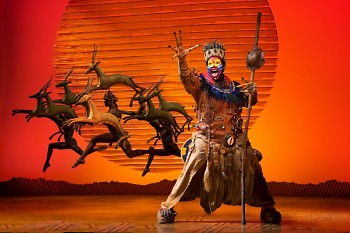A jealous brother kills the king. The prince tarries until, spurred by his father’s spirit, he finally takes action. The murderer himself dies.
You don’t expect overtones of Hamlet from movies with flatulent warthogs, but Disney’s The Lion King (1995) had serious ambitions. So did Julie Taymor’s stage version, which debuted two years later. Thanks to Broadway Grand Rapids, the latter recently had its Grand Rapids premiere.
It is astonishing.
Julie Taymor, the director whose vision infuses the show, conjures a world through shadow, silhouette, puppetry, bright clothing, powerful landscapes (some of which move), distant stars, and endless imagination. The world of the show is stranger than that of the film, and richer, and more African.
During the opening number, as animal puppets rose onto the stage and people sang in breathtaking harmony, I glanced at Gemma, my six-year-old daughter. She was open-mouthed and smiling.
Although the spectacle of it all remained its most distinguishing feature, the characters and the story weren’t neglected.Buyi Zama, who played the wise baboon Rafiki, was the best onstage, but Spencer Plachy’s Scar came a hot second. As the murderous uncle, he radiated arrogance and cunning.
My daughter grabbed my hand as young prince Simba and his friend Nala came to the elephant graveyard. She laughed as Zazu ran into a wall. And, as Simba’s father Mufasa spoke earnestly about the importance of caution, she asked, “When is the part with farting?”
So, yes: adults and children will see two different shows. As lionesses mourned dead Mufasa, Gemma was sad; I was amazed, instead, by the fabric hanging from their eyes, like permanent streams of tears. It felt like an image encountered in a myth, or a dream. The rising sun; Rafiki looking to the audience before disappearing into darkness; Mufasa’s face in the sky, breaking apart: these are images that will stay with me for a long time.
What an incredible show.
The Rapidian, a program of the 501(c)3 nonprofit Community Media Center, relies on the community’s support to help cover the cost of training reporters and publishing content.
We need your help.
If each of our readers and content creators who values this community platform help support its creation and maintenance, The Rapidian can continue to educate and facilitate a conversation around issues for years to come.
Please support The Rapidian and make a contribution today.
